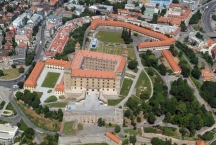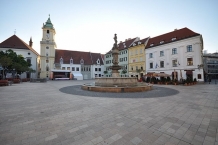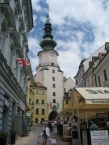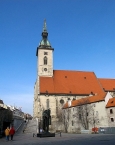Cycle Route Moravská cyklistická cesta
No. of cycle route 004
Actions
![]()
Please wait - map data are loading
Added on 15 Sep 2012,
last edited by biroto-Redaktion on 10 Jan 2021
Actions
Cycle route metrics
Total distance in km
116
Information about rights to the gps-track data | |
|---|---|
Rights owner | OpenStreetMap and Contributors + biroto-Redaktion (biroto.eu) |
Rights characteristic / license | Contains information from OpenStreetMap, which is made available here under the Open Database License(ODbL) |
Link to the description of the license | |
GPX file taken from | |
GPX file uploaded | by biroto-Redaktion on 10 Jan 2021
|
Track points in total
1.221
Track points per km (avg)
11
Start/endpoint
Start location
Karlova Ves, Region of Bratislava, SK (141 m NHN)
End location
Rohatec, Southeast, CZ (165 m NHN)
Beds4Cyclists, worth visiting and infrastructure
Name and address
Latitude / Longitude
Phone
Fax
Mobile
Type of accommodation
Rating for cyclists
Route km
Dist. to route
Elevation
1 km
2,1 km
157 m
Information about copyright | |
|---|---|
Rights owner | |
Rights characteristic / license | by-sa: CREATIVE COMMONS Attribution-ShareAlike |
Link to the description of the license | |
Image taken over from | https://commons.wikimedia.org/wiki/File:Pozsinycivertanéegi2.jpg |
Image has been uploaded | by biroto-Redaktion on 05 Jan 2015
|
Information about copyright | |
|---|---|
Rights owner | |
Rights characteristic / license | by: CREATIVE COMMONS Attribution |
Link to the description of the license | |
Image taken over from | |
Image has been uploaded | by biroto-Redaktion on 05 Jan 2015
|
Information about copyright | |
|---|---|
Rights owner | |
Rights characteristic / license | by-sa: CREATIVE COMMONS Attribution-ShareAlike |
Link to the description of the license | |
Image taken over from | |
Image has been uploaded | by biroto-Redaktion on 05 Jan 2015
|
Information about copyright | |
|---|---|
Rights owner | |
Rights characteristic / license | by-sa: CREATIVE COMMONS Attribution-ShareAlike |
Link to the description of the license | |
Image taken over from | https://commons.wikimedia.org/wiki/File:Bratislava_-_St._Martins_Cathedral.jpg |
Image has been uploaded | by biroto-Redaktion on 05 Jan 2015
|
Bratislava or Pozsony in Hungarian and Pressburg in German, is the capital and largest city in Slovakia. It has a population of almost 415,000 and is the administrative, cultural and economic centre of the country. Before 1919, it was known as Prešporok in Slovak.
Understand
Bratislava has a very pleasant medieval inner city with narrow, winding streets, a hill-top castle next to the river Danube, and many historic churches and buildings to visit. The old town is centered on two squares, Hlavne namestie (main square) and Hviezdoslavovo namestie (Hviezdoslav square, named after a famous Slovak poet). Of a rather different architectural character are some of the communist-era buildings found in the modern parts of the city; a prime example is Petrzalka housing estate, the biggest Communist-era concrete block housing complex in Central Europe, which stretches on endlessly just across the river. Move further east and there are plenty of rural places to explore. Farms, vineyards, agricultural land, and tiny villages are situated less than 50 kilometres to the north and east of Bratislava.
Today, Bratislava and its surroundings form the second-most prosperous region in Central and Eastern Europe.
History
After the fall of the Great Moravian Empire, Slovakia became part of the Kingdom of Hungary from the 10th century (later included with the Austro-Hungarian Empire) until the end of the First World War. The city was even the capital (1536-1784), the coronation city (1563-1830), and the seat of the diet (1536-1848) of the Kingdom of Hungary for three centuries. In this period, eleven Hungarian kings and queens were crowned at St. Martin's Cathedral. At that time, the city was called Preßburg in German and Pozsony in Hungarian, and had a clear German (42%) and Hungarian (40%) ethnic majority (1910 census). In 1919, the Treaty of Trianon created Czechoslovakia, and Bratislava was attached to the newly founded state. In the same year, the name Bratislava was officially adopted for the first time in history.
Between 1939 and 1944, Slovakia was a Nazi Germany-controlled state. In 1941–1942 and 1944–1945, the pro-Nazi Slovak government cooperated in deporting most of Bratislava's approximately 15,000 Jews. Bratislava was occupied by German troops in 1944, and eventually taken by the Soviet Red Army on 4 April 1945, after a failed insurrection of Slovak partisans, now commemorated as Slovenské národné povstanie, or "Slovak National Uprising".
After the Communist Party seized power in Czechoslovakia in February 1948, the city witnessed profound demographic and urban transformation, and in 1969 it became the capital city of the Slovak Socialist Republic, one of the two component state of federal Czechoslovakia.
Bratislava's dissidents anticipated the fall of Communism with the Bratislava candle demonstration in 1988, and the city became one of the foremost centres of the anti-Communist "Velvet Revolution" in 1989. In 1993, the city became the capital of the newly formed Slovak Republic following the "Velvet Divorce".
See
Bratislava Castle
- ⊙ Bratislava Castle (Bratislavský hrad), ☎ +421 2 5441 1444. The castle itself is already opened after reconstruction and hosts the exhibitions. There is also a restaurant at the castle open till after the actual castle tours into the night. Entrance is free.
Museums and galleries
For museum-goers, Bratislava is the place to go, with some bigger and loads of small museums around town. Every year in the weekend around 24 April Bratislava celebrates a festival called "Bratislava for All", giving locals and visitors alike the possibility to visit most of the facilities governed by the city for free or a reduced fee, this including most of the museums and galleries. In May, the city's museums and galleries keep their gates open to visitors until late at night, this being called the "Night of Museums and Galleries".
- Pharmacological Museum (Farmaceutické múzeum).
- ⊙Slovak National Gallery (SNG). For a taste of visual arts, pay a visit to the National Gallery at the embankment between Starý most and Nový most with permanent collections of Slovak and European medieval art pieces, although the temporary exhibitions tend to be far more interesting.
- ⊙Bratislava City Gallery (GMB). Bratislava City Gallery is also a good pick to see displays of historical fine arts, paintings and sculptures along with interesting temporary exhibitions.
- Danubiana Art Museum. If you like modern art better, pay a visit to the Danubiana Art Museum on the southern edge of Bratislava but be aware that it is too far for a stroll, with little to no public transport connections, and is best reached by car or taxi.
- Milan Dobes Museum. This small museum features modernist Op-art. It lies in the city center and is recommended to all interested in the development of modern art.
- ⊙ National Museum, Žižkova 14 (At the foot of Castle Hill), ☎ +421 2 5920 7273. An unique exhibition on ancient Egypt is being held here until end of August 2008, together with permanent archeological collections and more,
- Bratislava City Museum.
- Natural Science Museum, Vajanského nábrežie 2, ☎ +421 2 5934 9122. Echoing the communist era, the natural science exhibitions have an interesting collection of artifacts and is slowly being transformed into a modern era exhibition,
- Gerulata, Gerulatska ul. This is an ancient Roman military camp with archeological findings on display. If you're into all things Roman, you should also consider a visit to the nearby Carnuntum which has a large archeological site and is only a few minutes by car from Bratislava.
- Museum of Transport, Šancová 1/a, ☎ +421 2 5244 4163. With a display of historical vehicles, situated in the first railway station in the city, very close to the current Main Railway Station,
- Museum of Trade, Linzbothova 16, ☎ +421 2 4524 3167. This museum has some remarking pieces of historic advertising plates and other artifacts.
- Jewish Community Museum, Heydukova 11-13, ☎ +421 2 5441 6949. Rare Jewish ritual tools, gold-embroidered mantles protecting the holy biblical scrolls, unique photographs of students who had attended the famed Bratislava rabbi school that reveal even to this day the atrocities of the Holocaust. It is situated in the Heydukova Street Synagogue, which is the only synagogue in Bratislava. Constructed in 1923-1926, it is a Cubist building designed by the Bratislava-based Jewish architect Artur Szalatnai-Slatinský and is listed as a national cultural monument. Orthodox in orientation, the synagogue still serves as an active Jewish house of worship. The Jewish Community Museum with a permanent exhibition “The Jews of Bratislava and Their Heritage” is installed upstairs and during the summer season is open to the public up till September, every Friday 1 till 4PM and every Sunday 10AM-1PM.
- ⊙Museum of City History (in the old town hall), ☎ +421 2 5920 5130. Tue - Fri 10 am – 5 pm Sat – Sun 11am – 6 pm. Including the museums of history and music as well as the city dungeon and the exhibition on medieval justice. 5 €.
Churches
- ⊙St. Martin's Cathedral (Dóm sv. Martina). Nov-Mar: Mon-Sat 09:00-11:30, 13:00-16:00, Sun 13:30-16:00; Apr-Oct: Mon-Sat 09:00-11:30, 13:00-18:00, Sun 13:30-16:00. The largest and one of the oldest churches in Bratislava, situated below Bratislava Castle. The Gothic cathedral, formerly the coronation-church of several Hungarian kings, begun in 1204, and reconsecrated in 1445, was restored in 1861-80. The tower is surmounted by a pyramid bearing a gilded Hungarian royal crown. Entrance €2.
- St. Clare's Church (Kostol sv. Kláry). A Gothic church on Klariská street, in the historical center; currently used as a concert hall.
- Church of the Annunciation (Kostol Zvestovania / Františkáni / Františkánsky kostol).
- Church of the Holy Savior (Kostol Najsvätejšieho Spasitel'a).
- ⊙Church of St. Elisabeth (Kostol svätej Alžbety) (Located on Bezručova street). Nicknamed the Blue Church (Modrý kostolík), this is a beautiful Jugendstil church finished in 1913.
- Trinitarian Church of Bratislava (Kostol trinitárov) (On the Župné námestie square in the old town). free.
Other prominent buildings
- Primate's Palace (Primaciálny palác). Currently the seat of the Mayor of Bratislava.
- ⊙Old Town Hall (Stará radnica), Primaciálne square 3 (next to Primate's Palace). The Old Town Hall is open to the public as a museum.
- ⊙Grassalkovich Palace and gardens (Grassalkovičov palác). Or the Presidential Palace (Prezidentský palác) - a Rococo/late Baroque summer palace with a French garden, used as a seat of the President of Slovakia. In one of the garden's alleys you will see a row of trees planted by famous people such as Juan Carlos I (King of Spain). In front of the Palace you will see the Slovak National Guard.
- Mirbach Palace (Mirbachov palác).
- Palffy Palace (Pálffyho palác).
- Academia Istropolitana. The oldest historic University in the area, which is now occupied by the state of Slovakia, from the 13th century.
- Slovak National Theatre (Slovenské národné divadlo), Hviezdoslavovo square. The historic building of the Slovak National Theatre, built in 1886.
- ⊙Slovak Radio Building (Slovenský rozhlas). Its main building is a peculiar 60m high reversed pyramid from the communist era and a landmark in sharp contrast with the building of the Slovak National Bank just across the street.
Monuments
- Slavín monument. On the top of the hill behind the castle, overlooking the entire city. This is a monument in memory of Soviet casualties in the liberation battle of Bratislava in World War II. It is the highest place in the city, and thus the best place for viewing the city. Slavin actually is a cemetery and thus rather quiet. On warm nights it's a very romantic place, allowing you to sit in the shadows of the monument and look at the traffic below. To get there, take trolleybus no. 203 from Hodžovo námestie (in front of the Presidential Palace) in the direction Búdková and get off in 9 minutes at the last stop, then walk 500 m along Stará vinárska and then Pažického streets. Slavin is near an embassy district.
- Roland Fountain (Rolandova fontána). Built by stone cutter Andreas Luttringer and commissioned by Hungarian king Maximilian in 1527, this was the first fountain in Bratislava.
- ⊙Michael's Gate with Tower (Michalská brána). This 51m high tower above the gate with its green copper roof is one of the best known and the oldest buildings in Bratislava. It was built in the 14th century as one of the four gates to the city.
- ⊙Laurin's Gate (Laurinská brána).
- Chatam Sofer Mausoleum.
- Jewish Cemetery, Jewish Community Museum and Bratislava Synagogue, Heydukova. The only synagogue in Bratislava.
Other sights
- SNP Bridge (Most Slovenského národného povstania, called Nový most from 1993 to 2012). A bridge over the Danube river, with its flying saucer-shaped structure housing a restaurant called "UFO". There is an observation deck on its roof, open from 10:00-23:00 daily, offering great views of the old town, as well as the apartment blocks in Petržalka. Entrance costs €6.50, but is free of charge if you eat in the restaurant.
- ⊙Main Indoor Market (Tržnica at Trnavské mýto).
Information about copyright | |
|---|---|
Rights characteristic / license | by-sa: CREATIVE COMMONS Attribution-ShareAlike |
Link to the description of the license | |
Input taken over from: |
Wikivoyage contributors, 'Bratislava', Wikivoyage, The FREE worldwide travel guide that anyone can edit, 24 August 2016, 14:46 UTC, <https://en.wikivoyage.org/w/index.php?title=Bratislava&oldid=3039280> [accessed 1 October 2016] |
taken over / edited on | 05 Jan 2015 - 02 Oct 2016
|
taken over / edited by |
|
1 km
2,3 km
148 m
1 km
3,1 km
148 m
1 km
2,5 km
148 m
Hours of opening
April ‒ Oktober: Mo ‒ So 9:00 ‒ 19:00
November ‒ März: Mo ‒ So 9:00 ‒ 18.00
Languages spoken:
slovenčina ▪ English ▪ Deutsch
1 km
2,3 km
160 m
![]()




